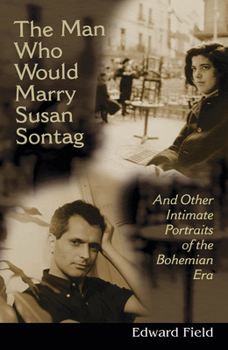The Man Who Would Marry Susan Sontag: And Other Intimate Literary Portraits of the Bohemian Era
Select Format
Select Condition 
Book Overview
Long before Stonewall, young Air Force veteran Edward Field, fresh from combat in WWII, threw himself into New York's literary bohemia, searching for fulfillment as a gay man and poet. In this vivid account of his avant-garde years in Greenwich Village and the bohemian outposts of Paris's Left Bank and Tangier--where you could write poetry, be radical, and be openly gay--Field opens the closet door to reveal, as never been seen before, some of...
Format:Hardcover
Language:English
ISBN:029921320X
ISBN13:9780299213206
Release Date:December 2005
Publisher:University of Wisconsin Press
Length:302 Pages
Weight:1.32 lbs.
Dimensions:1.1" x 6.3" x 9.3"
Customer Reviews
2 ratings
A Closet in Bohemia?
Published by Thriftbooks.com User , 17 years ago
[...] The bohemian scene in New York was one that consisted of many members from the world of literature. Edward Field was a member of that group. He like others was searching for achievement and fulfillment as both a gay man and as a poet. With four collections of poetry to his credit--two of which were prize winners--who better can describe the vibrant scene at that time? He writes about the avant garde in Greenwich Village as well as of what was going on in the salons of the Left Bank in Paris and in the outpost of Tangiers. It was possible to be openly gay in those places outside of America and he provides us with exciting portraits of some of the people of letters of the time--Susan Sontag, Alfred Chester, May Swenson, James Baldwin, Paul Bowles and Frank O'Hara. In doing so he gives a lively look at the romantic age when Bohemia was an alternative lifestyle. Edward Field, the author of this book, is plain-spoken as well as out spoken. He tells it like it was in this wonderful book at an age that contributed so much to the world of literature. At 70 years old, he manages to bring the bohemia of the 1950's to life once again. What he has written is a reminiscence which is made up of many little stories of people he knew, This is neither a social nor a literary history but a look at that group of people who chose to live as they saw fit. I suppose the book can be classified as a memoir which is centered on the sexual escapades of the people Field writes about. He describes for us the fertility of American artistry and does so with cheek and with openness. The focus is not exactly centered as the information is but it is beautifully written and so much fun to read. The salons of Greenwich Village brought us so much and the stories continue to keep coming. Field was there--in the midst of it all--and has something to say about what was transpiring. It is half gossip and the other half fascinating stories and some of the details are amazing. The literary world of the time was primarily carried by gays and lesbians and we know they have stores to tell. The writers that Field tells about are colorful people and their stories are all part of a larger whole crafted by this wonderful writer---he is candid and he is very perceptive (we should all be thankful for his memory). As a picture of Americana and literature, this is the book to read. As for the title, you will have to read the book to find out what it means.
memoir of the 1950s and Beat era mostly in Greenwich Village
Published by Thriftbooks.com User , 18 years ago
Field, an award-winning gay poet now in his seventies, brings the bohemianism of the 1950s alive. The content is a reminiscence made up mostly of vignettes of individuals Field knew rather than literary or social history; though the impress of the bohemianism centered in Greenwich Village on American literature and culture comes out. Susan Sontag, James Baldwin, May Swenson, Paul Bowles, and Frank O'Hara all make appearances, along with numerous other famed artists and little-known, yet still colorful individuals including the author's partner Neil Derrick. The six-page index consists entirely of the names of individuals Field portrays to varying degrees. Much of the memoir focuses on the sexual escapades and relationships of many characters and how the author and others got by as homosexuals in this era when this was not as open as it is today, yet nonetheless accepted in the limited, adventurous world of Greenwich Village. For Field's position in the local art scene, his wide circle of friends and acquaintances, and his extended treatment of the libertine sexual activity, the work is a basic source on this notable, particularly fertile vein of American artistic creativity.





